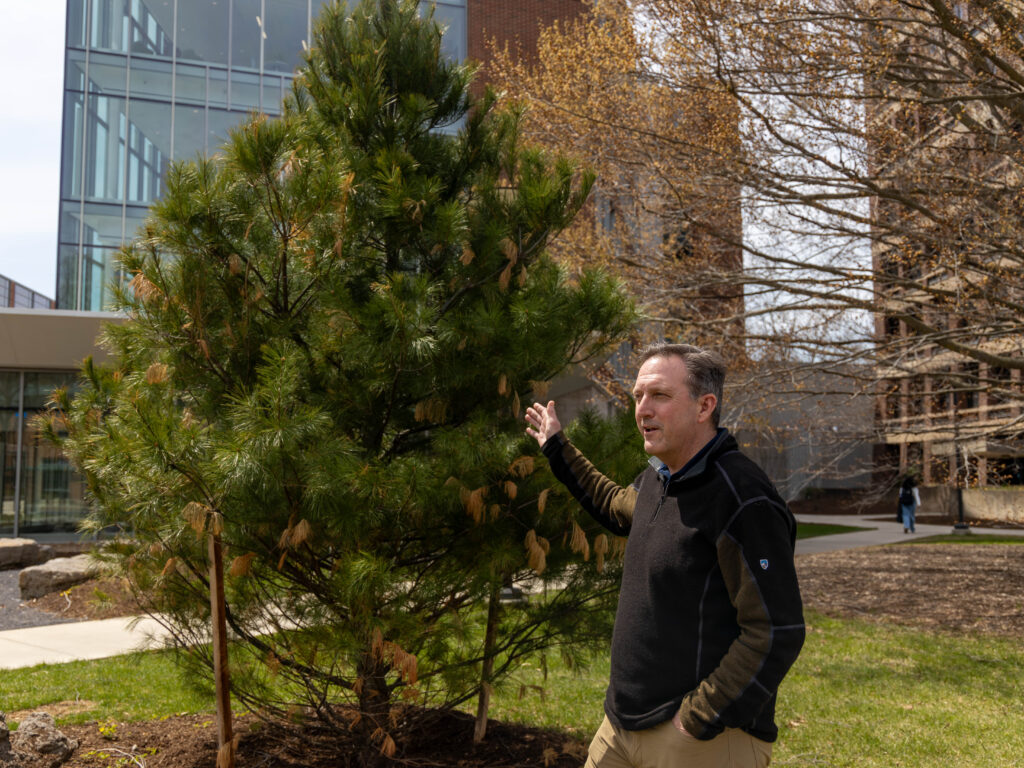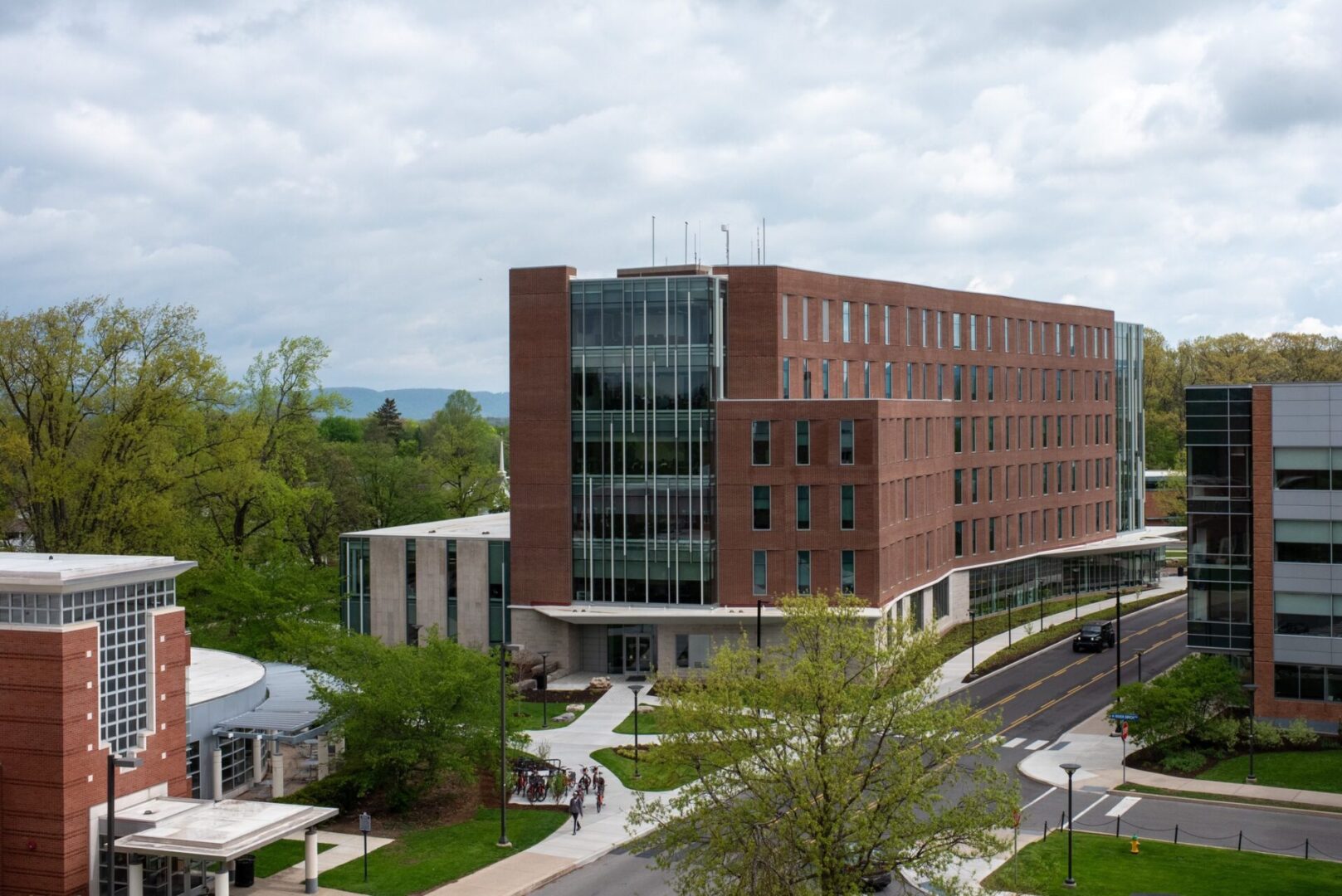By Penn State News
When it opened earlier this year, Penn State’s Susan Welch Liberal Arts Building came with all the ultra-modern, environmentally friendly amenities one would expect from the College of the Liberal Arts’ first new facility in more than a half-century.
But the building itself wasn’t the only thing that took careful thought and planning — just as much went into its surrounding grounds.
Representatives from the University’s Office of the Physical Plant collaborated with Liberal Arts staff and faculty to ensure that the building’s exterior landscaping includes native plants and trees that pay homage to the Indigenous Erie, Haudenosaunee (Seneca, Cayuga, Onondaga, Oneida, Mohawk, and Tuscarora), Lenape, Monongahela, Shawnee, Susquehannock, and Wahzhazhe nations, whose ancestral homelands now comprise the university’s campuses. The process relied on research from the field of ethnobotany, which focuses on the traditional practices related to plant usage within a particular culture.
Tom Flynn, manager of ground services for OPP, served as the project’s landscape architect and worked closely with a committee from the Department of Anthropology including James Doyle, director of the Matson Museum of Anthropology and associate research professor of anthropology; Chris Hort, Liberal Arts facilities manager; Derek Kalp, OPP landscape architect; project architect Bohlin Cywinski Jackson; and construction manager Turner Construction.
The landscaping consists of six distinct areas — Upland Hardwood Forest, Sweetgrass Prairie, Council Ring, Great Tree of Peace, Sunny Display Gardens, and Shady Display Gardens. Connected by pedestrian-friendly pathways, the spaces were designed to seamlessly blend with the larger campus landscape and to foster interaction, support accessibility, and create a welcoming environment for learning.
The planned grounds also align well with the Welch Building’s sustainable components, which include LEED (Leadership in Energy and Environmental Design) certification, bird-friendly glass, and changing rooms and showers meant to encourage people to bike or walk to work.
“From a sustainability perspective, it made sense to have plants that could thrive more naturally in their home environments. You want it to have high aesthetic appeal, but be functional as well,” Hort says. “And it was really important to us to give a nod to the Indigenous people of this area and recognize what was here on this campus before Penn State.”
Doyle says the thoughtful approach brought to the landscape design dovetails nicely with the collection of the Matson Museum, which moved from Carpenter Building to the Welch Building and officially opened in its new space in May.

“It was a meaningful way to bring what we’re doing in the museum and the anthropology department outside,” Doyle says. “A lot of things on view in our first installation here — pottery, bark cloth, feathers, fibers — are things that come from the landscape, so it’s great that our visitors can see how people from around the world interacted with their landscape and used it to clothe themselves or make regalia or useful things like pottery or baskets.”
A self-described “plant guy,” Flynn found the challenge exhilarating.
“The project was very rewarding and a lot of fun to pull together,” he says. “As far as the design goes, we had multiple meetings with James and the Indigenous Faculty Staff Alliance in terms of incorporating ethnobotany into the landscaping. It actually wasn’t much of a stretch because a lot of the plants we use have cultural significance. It gave me the opportunity to dig deeper into the native plants we already use, and think about and study as best I could the traditional uses of them by the Indigenous cultures, particularly for medicinal, religious, or utilitarian purposes.”
In the end, Flynn put together “a pretty hefty list” of botanicals, from flowers like wild geraniums and Virginia irises to shrubs like mountain laurels and common juniper.
Where to put the plants proved to be another challenge, given the limited greenspace and the fact that the building’s north side, nearest to Ford Building, “basically gets no sunlight,” Flynn says.
“Trying to balance the needs of the plant made for an interesting exercise in plant selection,” he says. “So, we have one display garden that highlights more the sunny plants these cultures used, and another with more shade-tolerant plants.”
Some parts of the landscaping were already there, such as the row of towering mature oak trees that make up most of the Upland Hardwood Forest on the north side of the building. It was imperative they be preserved — plus, they’re historically significant to Native American culture, Flynn says.
Other components were more outside the box, like the Sweetgrass Prairie on the building’s south side. The grass served a symbolic and functional use for Indigenous people, who burned it during ceremonies, dried and brewed it as tea, and converted it into goods.
“It’s not a plant I introduce to campus lightly, because it can be a very aggressive plant that could take over a landscape,” Flynn says. “It spreads by its roots system, so I didn’t have to worry about seeds floating in the air. I just had to block those roots from expanding beyond the footprint, which is why it was confined to that little area.”
The Council Ring encompasses a circular formation of large boulders excavated at various campus sites and meticulously moved and positioned by Flynn’s team at OPP. It’s designed to serve as a community gathering and collaboration space for students, faculty, and staff.
“Council rings were generally very important features for almost all Native American cultures I came across, for the same reasons I was going to be adding spaces for collaborating and outdoor gathering,” Flynn says. “And by making it a circle, no one is necessarily at the head of the table. It fosters improved communication among people.”
Then there’s the Great Tree of Peace — a white pine tree that symbolizes the Haudenosaunee symbol of law and peace and serves as a reminder of protection, unity, and tradition.
“According to their history, the meeting of the original five nations that comprised the Haudenosaunee confederacy occurred underneath a white pine tree,” says Flynn, noting the trees can grow to 100 feet tall. “With white pines, the needles come off the branch in a whirl, and there’s a cluster of five needles in one whirl. To the Haudenosaunee, that configuration represented the five nations.”
“The project was a real joy to do,” he says. “It was also very collaborative, and I really can’t say enough great things about our grounds team. Historically, there’s a long, long history of well-maintained grounds here at Penn State. This is just another great example of that.” T&G




